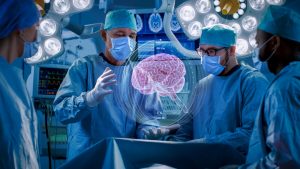Opinion
Augmented Reality and Brand Experiences: Examples and Business Opportunities for Enterprises

Augmented Reality and Brand Experiences: Examples and Business Opportunities for Enterprises
By Alfred Taren | April 9, 2020
The best brands are continuously seeking new and exciting ways to reach their target audience. The brands that hope to stay relevant need to express themselves in refreshing ways to make their consumer base take notice and pay attention. With the advent of augmented reality technologies, many companies are already working toward that goal, giving their customers a new way to engage through immersive interactions.

Two Engineers Works with Mobile Phone Using Augmented Reality Holographic Projection 3D Model of the Engine Turbine Prototype. Development of Virtual Mixed Reality Application.
Augmented Reality [AR] is the latest trend in new customer experiences, and it is working well for early adopters of the technology. Most consumers enjoy trying out new techniques and experiences, making the widespread inclusion of AR in applications a reality. Whether they’re using an app that lets them see new furniture in their homes, an app that applies different makeup to their faces, or an app that lets them walk through a real estate investment, AR applications offer consumers new and better ways to engage with brands.
AR is changing the way in which companies reach and interact with their customer base, helping them stay relevant in a flooded market. With augmented reality, engagement, conversion rates, and overall sales can increase simply by creating a better brand experience.
The current applications of augmented reality for businesses show promise, and the future of AR looks bright. Businesses in every industry can feel the positive effects of AR technologies, including the gaming, healthcare, real estate, education, and entertainment industries.
The Rise of Augmented Reality
Augmented reality is a technology that allows users to superimpose 3D objects into their physical world through a mobile device. Essentially, AR overlays digital information onto the existing environment to create a new environment. One popular example is Pokémon Go, wherein users catch Pokémon they can see in the real world through their smartphones.
Many tech companies are working on improving the framework and capabilities of AR, including Apple, which launched ARKit to help app developers meet this goal. Developers can now access new tools to produce stunning augmented reality and virtual reality applications.
Analysts predict continued market growth for the AR and VR industry, citing that in 2020, there will be more than one billion people using AR applications worldwide. However, even though analysts have made sizable estimates on the market growth for a unified AR and VR world, software developers feel strongly that AR is the future and will drive the majority of growth in immersive technology.
Why won’t VR be as big as AR? Virtual reality is far more complicated than augmented reality, requiring more attention for the user, who is fully immersed in a digital environment. This limits communication with the outside world while the technology is used. On the flip side, augmented reality allows users to interact with a digital world and the physical world at the same time. Users can implement AR into their everyday lives without the need for a special headset and closing themselves off from their environment. AR users can easily switch from using AR for gaming and business to shopping and entertainment, all while staying connected to the real world.

Augmented Reality (AR) information technology about nearby businesses and services on smartphone
Augmented Reality in Marketing
Many brands have already entered the AR field, integrating AR into their mobile device and browser applications for practical and marketing uses. Some example users include Home Depot, Timberland, Sephora, Chiquita, and Genius Ventures Inc.
In 2015, Home Depot released a way for customers to see how a paint color would look on their walls before they bought the paint. The Project Color app included ways to account for light, objects, and even shadows. This gave customers a realistic idea of how the color would look inside their real environment.
In 2017, Home Depot increased its AR offerings to include furniture and furnishings. Now, customers can see how colors would look on their walls and how various furniture items would look in their homes. This technology has since been adopted by Lowe’s and IKEA, too.
Timberland has also taken advantage of augmented reality, offering a virtual dressing room that allows customers to see their faces on a model body with features similar to their own. Users can then try on different clothes and accessories that the brand sells before they purchase them. Customers have a better understanding of how the clothing will look before they invest in the items, saving time and money.
Sephora offers a virtual makeup artist program inside their app that lets customers try on high-end makeup and different combinations without having to buy the makeup first. While many people prefer purchasing their makeup in-store, some people don’t have that luxury or the time. Sephora’s virtual artist app eliminates those barriers and brings the makeup studio to users’ homes.
Chiquita has partnered with Shazam to show customers exactly where their bananas came from. The new transparency app follows the entire route of bananas from Latin America to their destination. The goal is to help consumers understand the sustainability practices Chiquita is using. To view the life of the banana, users scan the blue sticker on the banana in the Shazam app and watch the virtual journey take flight on their phones.
This year, To celebrate their 50th anniversary Superstar shoe, Adidas and WSS teamed up Genius Ventures Inc to create an in-store Augmented Reality Snapchat activation. This in-store activation with Snapchat code was highly successful, so successful, that they moved on to a second phase to include a coupon-code for a free hat upon making their purchase in-store.
ADIDAS x WSS – Snapchat Activation – Augmented Reality
[youtube https://www.youtube.com/watch?v=G5C8c_7oLrM&w=560&h=315]
Augmented Reality in Other Industries
Another example of AR integration is in the insurance industry. Insurance companies are providing ways for customers to show real-time views of damage from traffic accidents and natural disasters. On the other end of the video, operators use AR to gain a better picture of the damage, measure different aspects, and estimate the full extent of the damage and the future costs of repairs. AR accelerates the reimbursement process.

Surgeons Perform Brain Surgery Using Augmented Reality, Animated 3D Brain. High Tech Technologically Advanced Hospital.
In the healthcare industry, augmented reality gives medical students the ability to train in AR environments with mannequins that are overlaid with AR to simulate real diseases and treatments. Physicians are learning more through access to AR, and students have a more in-depth understanding of medical procedures before they enter hospitals.
Augmented Reality: The Future of Customer Experience
AR is rapidly changing the way that consumers communicate with businesses. In retail, the implications of AR in marketing are enormous and promise increased engagement and sales. AR is also taking over education, healthcare, and even the way people interact with their insurance companies.
AR is becoming more widespread and more convenient for mainstream audiences and is continually integrated into more applications and industries, making it more accessible. The technology is an ideal tool for many different brands to utilize in their marketing tactics, offering new and exciting ways to reach their customer base.
| Alfred Taren | President |
| a: Genius Ventures Inc | Los Angeles | Vancouver e: alfred@geniusventuresinc.com | w: www.geniusventuresinc.com p: + 1 626 736 3625 |
Opinion
Surge in Unemployment Among California Youth Linked to Minimum Wage Hikes

“We have to stop touting the minimum wage as a completely harmless policy, or as some kind of remedy for poverty and income inequality… it is neither.”
In the past 18 months, California’s unemployment rate has jumped to the highest in the nation and a new analysis by Beacon Economics suggests that this peculiar increase could be a direct result of the state’s recent minimum wage hikes. Most concerning, according to the report, is that the current unemployment effect is specifically harming some of California’s most vulnerable residents—the state’s youth.
The new report highlights the fact that 90% of newly unemployed Californians over the past year and a half are under the age of 35 with the hardest hit group being teenagers. “This loss of youth work opportunity carries with it real long-run harm,” said Christopher Thornberg, Founding Partner of Beacon Economics and co-author of the new analysis. “It not only denies younger workers a critical source of income it deprives them of work experience that has been empirically shown to improve their chances of long-run success.”
While the recent rise in unemployment in California has occurred in tandem with the state’s minimum wage hikes, the relationship likely extends beyond mere correlation. According to the analysis, the jump in unemployment is incongruous with other measures of the California economy, which have continued to expand at a respectable rate. In fact, both output and household income in the state are robust and growing either faster than or similar to the nation overall. Yet, the unemployment rate in the United States as a whole has barely budged in the past 24 months.
And there is yet another anomaly: throughout the recent rise in unemployment, there has been no corresponding increase in unemployment insurance claims. If laid off tech and entertainment industry workers were driving California’s higher unemployment rate, it would almost certainly be reflected, at least to some degree, in UI claims, according to the analysis.
“For far too long, researchers and advocates alike have held up the minimum wage as a harmless and effective policy remedy for poverty and income inequality, but it is neither of those things,” said Thornberg. “Evidence has shown us that minimum wages don’t do much to address the ills they are intended to correct, but carry a substantial cost, particularly for our state’s future workers.”
Although well intentioned, Thornberg, and co-author Niree Kodaverdian, argue that higher minimum wages cause prices to increase, which end up reducing real incomes for lower-skilled workers. Available data and past empirical studies show that wage floors do very little to divert income from higher income workers to lower income ones, which is how minimum wage laws are typically characterized by proponents.
The specific effect on youth is caused because as labor costs go up relative to other inputs, employers who might have used lower-skilled, entry level workers, such as teenagers, move towards hiring older, more experienced workers, according to the analysis. The idea is that if an employer is legally obligated to pay a higher wage, they will naturally hire more skilled and productive workers to offset higher labor costs. Since those under age 25 make up nearly half of minimum wage workers, this restructuring disproportionally affects the state’s youth.
The report firmly acknowledges the need for policies to help alleviate the strain on lower income households in pricey California but argues that this particular policy remedy doesn’t work as intended, and when pushed too far, can inflict real harm on some of the state’s most vulnerable residents. Better policy options, according to the authors, include the Earned Income Tax Credit, early childhood education, and increased training for lower-skilled adults.
The full analysis can be found here.
Health & Wellness
Conquering Hanger: Smart Strategies for Balanced Blood Sugar

Stay Energized and Focused with These Proactive Tips for Managing Hunger and Mood
Wellness Tips By Sarah Goudie, Nutrition Expert & Guest Writer for IEBJ
We’ve all been there: mornings rushed, constant pivots throughout the day, and suddenly it’s 7 pm with no thought given to food. Looking back on those moments, we all know what we resort to when we’re hangry.
Irritable. Scatterbrained. Shaky. Weak. Reduced impulse control. Tanked.
It’s simply the connection between our stomach and brain, as blood sugar levels can affect the release of hormones like adrenaline and cortisol, the fight or flight and stress hormones.
So, let’s address this blood sugar regulation/hangry cycle by taking care of ourselves in a few different ways.
- Prioritize Protein and Fat Before Your Morning Coffee: Your first meal sets the tone for the day ahead. Starting with protein before your coffee or favorite pastry can help stabilize blood sugar levels and provide satisfaction and sustenance. A handy tip: prepare a batch of hard-boiled eggs or protein pancakes on your day off for convenient grab-and-go options before you head out. Trust me, cold protein pancakes make for a quick and nutritious bite on your way to work! (Try the recipe below!)
- Opt for Balanced Meals: When you have a chance to eat, even if it’s not your ideal meal, prioritize finishing your protein first, followed by your veggies and fruits. If you’re including simple carbohydrates, save those for the end of your meal. This meal sequencing helps regulate blood sugar levels and mood.
- Plan Ahead—Even Days in Advance: Sometimes, waking up 15 minutes earlier isn’t enough to ensure a nourishing breakfast and packed lunch. However, planning earlier in the week can alleviate the morning rush before you start your day. I often create a menu tailored to my work week, carefully considering seasonal foods and my personal goals. While meal prepping is fantastic if you have the time and enjoy leftovers, simply having a plan and doing the shopping can empower you and reassure you that your kitchen is stocked and ready.
- Slow Down: The quality of the foods we eat is important (think locally sourced, sustainable, clean), but so is the timing of our meals, as well as our mood and our focus while eating. Be intentional about meal times—sit down, step away from your desk, TV, or phone, and fully immerse yourself in the experience of eating. Many times, we eat quickly without being mindful. If you must eat on the go, find a quiet spot, whether it’s a park bench or pulled over in your car. Take the time to see, smell, and taste your food.
- SNACK SMART: This last tip is bolded for good reason—it has been a lifesaver for me countless times. Pack snacks. Every day. ESPECIALLY WHEN TRAVELING. We never know what the day will bring, so we must be prepared when we can’t access a full meal. Some of my favorite go-to snacks include “That’s It” bars, “RX” bars, a handful of macadamia nuts, or Paleo Valley protein sticks…not to mention my favorite reusable water bottle (complete with a straw designed to fit perfectly in my car cup holder). Being armed with snacks containing essential nutrients (fat, carbs, protein, and fiber) will help you navigate those moments when you’re tempted to make a fast food run.
*On the topic of fast food: Stay tuned for next month’s article, where I’ll unveil my top picks for healthier alternatives on those unavoidable drive-thru days!
Leaning into these proactive steps can revolutionize your approach to mindful fuel for your body. Embracing protein-rich breakfasts, balanced meal strategies, proactive planning, mindful eating habits, and smart snacking choices nourishes your body. It cultivates a deeper connection with your food and overall well-being. You can take charge of your dietary journey, one thoughtful bite at a time, and savor the rewards of a healthier, more vibrant life.
Check out my favorite protein pancake recipe!
- Servings: 6 small pancakes
- 1 large banana
- 2 large eggs
- 1/2 tsp cinnamon
- 1 tablespoon coconut oil for pan
- 1 scoop of your preferred protein powder
- 1. Preheat skillet
- 2. Blend ingredients above
- 3. Use the coconut oil to prep the pan
- 4. Cook till golden brown
- 5. Serve warm, and add some fun toppings! My go-to toppings are hemp seeds, fresh seasonal fruit, a scoop of almond butter, and a drizzle of honey.
Career & Workplace
California Continues to Struggle with Labor Supply as Employment Expands Modestly

State’s Unemployment Rate Remains Highest In Nation
California’s labor market expanded modestly in April, with total nonfarm employment in the state growing by 5,200 positions over the month, according to an analysis released today by Beacon Economics. March’s gains were revised down to 18,200 in the latest numbers, a 10,100 decline from the preliminary estimate of 28,300.
As of April 2024, California has recovered all of the jobs that were lost in March and April 2020, and there are now 314,300 more people employed in the state compared to February 2020. Total nonfarm employment has grown 1.8% over this time compared to a 3.9% increase in the United States overall. California increased payrolls by 1.2% from April 2023 to April 2024, trailing the 1.8% increase nationally over the same period.
The state’s unemployment rate held steady at 5.3% in April 2024, unchanged from the previous month. California’s unemployment rate is the highest in the nation and remains elevated relative to the 3.9% rate in the United States as a whole. The state continues to struggle with its labor supply, which remained essentially unchanged in April (declining by a negligible 100). Since February 2020, California’s labor force has fallen by -246,200 workers, a -1.3% decline. In comparison, over the past twelve months the nation’s labor force has increased by 0.8%.
Industry Profile
- At the industry level, job gains were mixed in April. Health Care led the way with payrolls expanding by 10,100, an increase of 0.4% on a month-over-month basis. With these gains Health Care payrolls are now 13.6% above their pre-pandemic peak.
- Other sectors posting strong gains during the month were Transportation, Warehousing, and Utilities (3,700 or 0.4%), Leisure and Hospitality (3,100 or 0.2%), Government (2,600 or 0.1%), Education (1,800 or 0.4%), Retail Trade (1,000 or 0.1%), and Wholesale Trade (400 or 0.1%).
- Payrolls decreased a handful of sectors in April. Construction experienced the largest declines, with payrolls falling by -6,000, a contraction of -0.6% on a month-over-month basis. Note that this decline was largely due to late season storms affecting construction projects across the state.
- Other sectors posting significant declines during the month were Manufacturing (-5,300 or -0.4%), Professional, Scientific, and Technical Services (-3,600 or -0.3%), Real Estate (-700 or -0.2%), Finance and Insurance (-700 or -0.1%), Administrative Support (-600 or -0.1%), and Information (-600 or -0.1%).
Regional Profile
- Regionally, job gains were led by Southern California. Los Angeles (MD) saw the largest increase, where payrolls grew by 5,700 (0.2%) during the month. The Inland Empire (2,600 or 0.2%) and San Diego (1,200 or 0.1%) also saw their payrolls jump during the month. However, payrolls fell in Orange County (-2,700 or -0.2%), Ventura (-500 or -0.2%), and El Centro (-2,200 or -0.3%). Over the past year, El Centro (1.9%) has had the fastest job growth in the region, followed by the Inland Empire (1.5%), Ventura (1.4%), Orange County (1.1%), San Diego (0.8%), and Los Angeles (MD) (0.6%).
- In the Bay Area, the East Bay experienced the largest increase, with payrolls expanding by 2,600 (0.2%) positions in April. San Rafael (MD) (200 or 0.2%) and Napa (100 or 0.1%) also saw payrolls increase during the month. However, San Francisco (MD) (-1,700 or -0.1%), Santa Rosa (-600 or -0.3%), and Vallejo (-600 or -0.2%) experienced payroll declines during the month. Over the past 12 months, Vallejo (3.0%) enjoyed the fastest job growth in the region, followed by Santa Rosa (2.3%), Napa (2.2%), San Rafael (MD) (1.6%), the East Bay (0.9%), San Jose (0.2%), and San Francisco (MD) (-0.8%).
- In the Central Valley, Sacramento experienced the largest monthly increase as payrolls expanded by 900 (0.1%) positions in April. Payrolls in Yuba (400 or 0.8%), Bakersfield (300 or 0.1%), Fresno (300 or 0.1%), and Visalia (100 or 0.1%) increased as well. However, payrolls fell in Stockton (-500 or -0.2%), Modesto (-200 or -0.1%), Merced (-200 or -0.3%), Redding (-100 or -0.1%), and Hanford (-100 or -0.2%). Over the past year, Madera (5.7%) had the fastest growth, followed by Yuba (4.2%), Merced (3.7%), Modesto (3.6%), Sacramento (2.5%), Hanford (2.4%), Redding (2.3%), Fresno (2.2%), Visalia (2.1%), Stockton (2.0%), Chico (1.5%), and Bakersfield (1.1%).
- On California’s Central Coast, Salinas (200 or 0.1%) and Santa Cruz (200 or 0.2%) added the largest number of jobs during the month. Santa Barbara (-100 or -0.1%) saw payrolls decline. From April 2023 to April 2024, Salinas (1.9%) has added jobs at the fastest rate, followed by Santa Cruz (1.6%), Santa Barbara (0.8%), and San Luis Obispo (0.5%).
-

 Opinion1 month ago
Opinion1 month agoSurge in Unemployment Among California Youth Linked to Minimum Wage Hikes
-

 Commercial Real Estate Transactions3 weeks ago
Commercial Real Estate Transactions3 weeks agoSRS Real Estate Partners Announces Record-Breaking $6.15 Million Ground Lease Sale of a New Construction Chick-fil-A Property in Murrieta, California
-

 Health & Wellness3 weeks ago
Health & Wellness3 weeks agoBuddha Bars: A Mother’s Innovative Solution to Healthy Snacking
-
By Press Release1 week ago
California Employment Expansion Continues But Still Trails Nation








